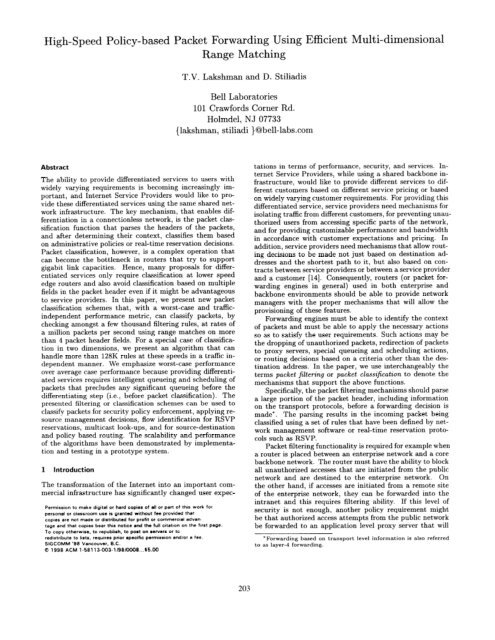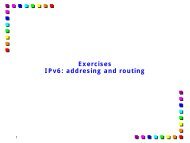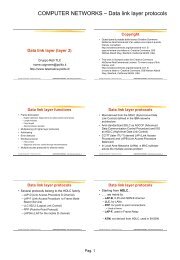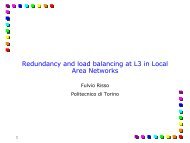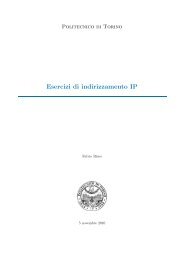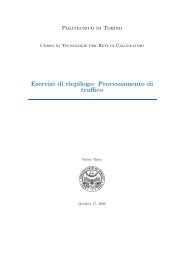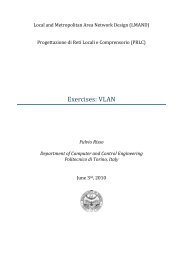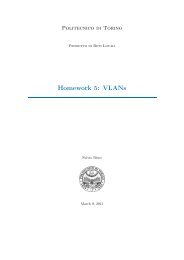High-Speed Policy-based Packet Forwarding Using Efficient Multi ...
High-Speed Policy-based Packet Forwarding Using Efficient Multi ...
High-Speed Policy-based Packet Forwarding Using Efficient Multi ...
You also want an ePaper? Increase the reach of your titles
YUMPU automatically turns print PDFs into web optimized ePapers that Google loves.
<strong>High</strong>-<strong>Speed</strong> <strong>Policy</strong>-<strong>based</strong> <strong>Packet</strong> <strong>Forwarding</strong> <strong>Using</strong> <strong>Efficient</strong> <strong>Multi</strong>-dimensional<br />
Range Matching<br />
T.V. Lakshman and D. Stiliadis<br />
Bell Laboratories<br />
101 Crawfords Corner Rd.<br />
HolmdeP, NJ 07733<br />
{lakshman, stiliadi )@bell-labs.com<br />
Abstract<br />
The ability to provide differentiated services to users with<br />
widely varying requirements is becoming increasingly important,<br />
and Internet Service Providers would like to provide<br />
these differentiated services using the same shared network<br />
infrastructure. The key mechanism, that enables differentiation<br />
in a connectionless network, is the packet classification<br />
function that parses the headers of the packets,<br />
and after determining their context, classifies them <strong>based</strong><br />
on administrative policies or real-time reservation decisions.<br />
<strong>Packet</strong> classification, however, is a complex operation that<br />
can become the bottleneck in routers that try to support<br />
gigabit link capacities. Hence, many proposals for differentiated<br />
services only require classification at lower speed<br />
edge routers and also avoid classification <strong>based</strong> on multiple<br />
fields in the packet header even if it might be advantageous<br />
to service providers. In this paper, we present new packet<br />
classification schemes that, with a worst-case and trafficindependent<br />
performance metric, can classify packets, by<br />
checking amongst a few thousand filtering rules, at rates of<br />
a million packets per second using range matches on more<br />
than 4 packet header fields. For a special case of classification<br />
in two dimensions, we present an algorithm that can<br />
handle more than 128K rules at these speeds in a traffic independent<br />
manner. We emphasize worst-case performance<br />
over average case performance because providing differentiated<br />
services requires intelligent queueing and scheduling of<br />
packets that precludes any significant queueing before the<br />
differentiating step (i.e., before packet classification). The<br />
presented filtering or classification schemes can be used to<br />
classify packets for security policy enforcement, applying resource<br />
management decisions, flow identification for RSVP<br />
reservations, multicast look-ups, and for source-destination<br />
and policy <strong>based</strong> routing. The scalability and performance<br />
of the algorithms have been demonstrated by implementation<br />
and testing in a prototype system.<br />
1 Introduction<br />
The transformation of the Internet into an important commercial<br />
infrastructure has significantly changed user expec-<br />
Permission to mahe digital or hard copies of all or pert of thos work for<br />
personal or classroom use is granted without fee provided that<br />
copses are not made or distributed for profit or commewal adven<br />
tage end that copies bear this notice and the full cotat~on on the first page.<br />
To copy otherwise. to republish. to post on swvers or to<br />
redlstributs to ksts. reqwres prior specific permissoon and/or B fee.<br />
SIGCOMM ‘98 Vancouver. B.C.<br />
0 1999 ACM l-58113.003.1/98/0008...85.00<br />
tations in terms of performance, security, and services. Internet<br />
Service Providers, while using a shared backbone infrastructure,<br />
would like to provide different services to different<br />
customers <strong>based</strong> on different service pricing or <strong>based</strong><br />
on widely varying customer requirements. For providing this<br />
differentiated service, service providers need mechanisms for<br />
isolating traffic from different customers, for preventing unauthorized<br />
users from accessing specific parts of the network,<br />
and for providing customizable performance and bandwidth<br />
in accordance with customer expectations and pricing. In<br />
addition, service providers need mechanisms that allow routing<br />
decisions to be made not just <strong>based</strong> on destination addresses<br />
and the shortest path to it, but also <strong>based</strong> on contracts<br />
between service providers or between a service provider<br />
and a customer [14]. Consequently, routers (or packet forwarding<br />
engines in general) used in both enterprise and<br />
backbone environments should be able to provide network<br />
managers with the proper mechanisms that will allow the<br />
provisioning of these features.<br />
<strong>Forwarding</strong> engines must be able to identify the context<br />
of packets and must be able to apply the necessary actions<br />
so as to satisfy the user requirements. Such actions may be<br />
the dropping of unauthorized packets, redirection of packets<br />
to proxy servers, special queueing and scheduling actions,<br />
or routing decisions <strong>based</strong> on a criteria other than the destination<br />
address. In the paper, we use interchangeably the<br />
terms packet filtering or packet class$cation to denote the<br />
mechanisms that support the above functions.<br />
Specifically, the packet filtering mechanisms should parse<br />
a large portion of the packet header, including information<br />
on the transport protocols, before a forwarding decision is<br />
made*. The parsing results in the incoming packet being<br />
classified using a set of rules that have been defined by network<br />
management software or real-time reservation protocols<br />
such as RSVP.<br />
<strong>Packet</strong> filtering functionality is required for example when<br />
a router is placed between an enterprise network and a core<br />
backbone network. The router must have the ability to block<br />
all unauthorized accesses that are initiated from the public<br />
network and are destined to the enterprise network. On<br />
the other hand, if accesses are initiated from a remote site<br />
of the enterprise network, they can be forwarded into the<br />
intranet and this requires filtering ability. If this level of<br />
security is not enough, another policy requirement might<br />
be that authorized access attempts from the public network<br />
be forwarded to an application level proxy server that will<br />
*<strong>Forwarding</strong> <strong>based</strong> on transport level information is also referred<br />
to as layer-4 forwarding.<br />
203
authenticate the access. Clearly, filtering mechanisms are<br />
very useful at the edge of an enterprise network. In an edge<br />
network node, the router might need to identify the traffic<br />
that is initiated from specific customers, and either police<br />
it or shape it to meet a predefined contract. Indeed, these<br />
are the actions that are required by some of the differentiated<br />
services model proposals that are being considered for<br />
standardization by the IETF [lo].<br />
It is evident that most filter rules naturally apply to a<br />
whole range of addresses, port numbers, or protocols, and<br />
not just to single predefined hosts or applications. Aggregation,<br />
for instance of addresses, is not only required because<br />
customers are usually allocated blocks of addresses,<br />
but also because it is necessary to keep the network manageable.<br />
Therefore, the specification of the packet classification<br />
policies must allow aggregations in their definitions. This<br />
means that packet classification algorithms must be be able<br />
to process rules that define combinations of ranges of values.<br />
If the algorithms can only handle exact values and do not<br />
support aggregation, preprocessing is required to translate<br />
the ranges to exact values. This is infeasible since ranges<br />
can grow exponentially with length of the packet field on<br />
which the ranges are defined.<br />
A trend worth noting is that even though packet filtering<br />
was thought of as a tool necessary only at the network access<br />
points and mainly for firewall or security applications,<br />
it is now becoming apparent that it is a valuable tool for<br />
performing traffic engineering and meeting the new service<br />
requirements of the commercial Internet. Filtering policies<br />
that use the full information of the packet header can be<br />
defined for distributing the available system or network resources.<br />
The main consequence of these new uses is that<br />
all packet classification actions must be performed at wirespeed,<br />
i.e., the forwarding engines must have enough processing<br />
power to be able to process every arriving packet<br />
without queueing since without header processing it is not<br />
possible to differentiate packets to provide differentiated services.<br />
The main contributions of this paper are algorithms that<br />
use multi-dimensional range matching that enable Gigabit<br />
routers to provide wire-speed packet filtering and classification<br />
in a traffic independent manner (i.e. we do not<br />
rely on traffic dependent caching or average case results to<br />
achieve fast execution times). To our knowledge, our proposed<br />
schemes are the first schemes that allow thousands of<br />
filter rules to be processed at speeds of millions of packets<br />
per second with range matches on 5 or more packet fields<br />
in a traffic independent manner. Specifically, we present<br />
three algorithms: The first algorithm takes advantage of<br />
bit-level parallelism which combined with very elementary<br />
bit-operations results in a scheme that supports a large number<br />
of filter rules. The second algorithm extends the performance<br />
of the first algorithm by making efficient use of memory.<br />
It provides a means for balancing the the time-space<br />
tradeoff in implementation, and allows optimization for a<br />
particular system taking into account the available time for<br />
packet processing, the available memory, and the number<br />
of filter rules to be processed. Furthermore, the algorithm<br />
allows on-chip memory to be used in an efficient and traffic<br />
independent manner for reducing worst-case execution time.<br />
This is unlike typical caching schemes which are heavily traffic<br />
dependent and only improve average case performance.<br />
The performance metric for all our schemes is worst-case<br />
execution time, simple operations to make it amenable to<br />
hardware implementation if necessary, and space requirements<br />
which are feasible with current memory technology<br />
and costs. The implementation simplicity, scalability and<br />
performance of our filtering have been demonstrated in a<br />
prototype router with interfaces operating at a million packets<br />
per second.<br />
Our third algorithm considers the special case of filter<br />
rules on two fields. This is motivated by important applications<br />
such look-ups for multicast traffic forwarding and<br />
policy-<strong>based</strong> routing. To elaborate on this example, when<br />
a forwarding engine supports a multicast protocol like PIM<br />
(sparse mode or dense mode) [13] or DVMRP [26], the forwarding<br />
decision has to be made on both the source address<br />
value and the multicast group value. Depending on the protocol,<br />
the forwarding engine may have a forwarding entry<br />
for a given group value irrespective of source addresses, and<br />
also have forwarding entries for a given group value and<br />
source subnet. Given the increasing importance of multicast<br />
forwarding in the Internet, it would be ideal if a simple<br />
algorithm could be used for making multicast forwarding<br />
decisions. Since the search for the source addresses may use<br />
the same forwarding information base as that used for unicast<br />
routing, the same type of CIDR (Classless Inter-Domain<br />
Routing) aggregations [15] are likely to be used. CIDR aggregations<br />
introduced the notion of prefix in the definition<br />
of routing entries. In other words an entry in the forwarding<br />
base is defined as a value and a mask. The mask defines the<br />
number of bits of the destination address of a packet that<br />
can be ignored when trying to match the destination ad-<br />
dress of the packet to the particular entry of the forwarding<br />
base. The bits that can be masked-out are always in the<br />
less significant portion of the address. Thus, the values in<br />
the forwarding engines can thought as prefixes. For the case<br />
of IPv4, prefixes can have a length between 1 and 32 bits.<br />
We present a linear space, O(prefix length) scheme which<br />
can be used to implement P-dimensional lookups at rates of<br />
millions of packets per second for more than 128K entries in<br />
the forwarding table. Considering that multicast forwarding<br />
tables in the core backbone might include several hundreds<br />
of thousands of entries, even a solution that uses O(n log n)<br />
space with a moderate constant or O(Zog2n) time may not<br />
be feasible when the number of entries n is that high.<br />
2 Design Goals<br />
We first try to identify the main requirements that a packet<br />
classification algorithm must satisfy in order to be useful in<br />
practice.<br />
2.1 The Requirement for Real-Time Operation<br />
Traditional router architectures are <strong>based</strong> on flow-cache architectures<br />
to classify packets. The basic idea is that packet<br />
arrivals define flows [9, 171, in the sense that if a packet belonging<br />
to a new flow arrives, then more packets belonging<br />
to that flow can be expected to arrive in the near future.<br />
With this expected behavior, the first packet of a flow is<br />
processed through a slow path that analyzes the complete<br />
header. The header of the packet is then inserted into a<br />
cache or hash table together with the action that must be<br />
applied to the first packet as well as to all other packets of<br />
the flow. When subsequent packets of that flow arrive the<br />
corresponding action can be determined from the cache or<br />
hash table.<br />
There are three main problems associated with this architecture<br />
or any similar cache-<strong>based</strong> architecture when applied<br />
to current Internet requirements:<br />
204
1. In current backbone routers, the number of flows that<br />
are active at a given interface is extremely high. Recent<br />
studies have shown that an OC-3 interface might<br />
have an average of 256K flows active concurrently [24]<br />
t” For this many number of flows, use of hardware<br />
caches is extremely difficult, especially if we consider<br />
the fact that a fully-associative hardware cache may be<br />
required. Caches of such size will most likely be implemented<br />
as hash tables since hash tables can be scaled<br />
to these sizes. However, the O(1) look-up time of a<br />
hash table is an average case result and the worst-case<br />
performance of a hash table can be poor since multiple<br />
headers might hash into the same location. The number<br />
of bits in the packet headers that must be parsed<br />
is typically between 100 and 200 bits, and even hash<br />
tables are limited to only a couple of million entries.<br />
So any hash function that is used must be able to randomly<br />
distribute 100 to 200 bit keys of the header to<br />
no more than 20-24 bits of hash index. Since there is<br />
no knowledge about the distribution of the header values<br />
of the packets that arrive to the router, the design<br />
a good hash function is not trivial.<br />
2. Due to the large number of flows that are simultaneously<br />
active in a router and due to the fact that hash<br />
tables generally cannot guarantee good hashing under<br />
all arrival patterns, the performance of cache <strong>based</strong><br />
schemes is heavily traffic dependent. If a large number<br />
of new flows arrive at the same time, the slow path<br />
of the system that implements the complete header<br />
matching can be temporarily overloaded. This will result<br />
in queueing of packets before they are processed.<br />
But in this case, no intelligent mechanism can be applied<br />
for buffering and scheduling of these packets because<br />
without header processing there is no information<br />
available about the destination of the packets or<br />
about any other fields relevant to differentiation. So it<br />
is possible that congestion and packet dropping happen<br />
due to processing overload and not due to output<br />
link congestion.<br />
To better illustrate this, consider the model in Figure<br />
1. <strong>Packet</strong>s arrive to the interfaces and are placed<br />
in a queue for processing. After the packet classification<br />
and next-hop lookup operations are performed,<br />
they are forwarded to the outgoing interfaces where<br />
they are queued for transmission. Clearly, some interfaces<br />
may be idle even though there are packets waiting<br />
to be transmitted in the input queues. For example,<br />
all packets destined for output 1 can be blocked in<br />
the slow path processing module behind packets that<br />
are destined to other outputs. Output 1 remains idle,<br />
although there are packets in the buffers available for<br />
transmission. Obviously such a system will suffer from<br />
Head-of-Line blocking that will limit the throughput<br />
substantially. Note, that the Head-of-Line problem<br />
can be diminished, if there is knowledge about the<br />
destination of more than one enqueued packet [20].<br />
However, the fundamental problem of the system of<br />
Figure 1 is that the destination or the context of the<br />
packet is not actually known before the packet is processed.<br />
Thus, it is impossible to apply any intelligent<br />
‘Note the by active we do not imply that the flow currently has<br />
a backlog of packets to be served. The definition of active flows<br />
for caching look-up information is different from the definition for<br />
scheduling because caching information changes at a slower time scale.<br />
3.<br />
queueing mechanisms at the input queues and headof-line<br />
blocking cannot be eliminated.<br />
A commercial Internet infrastructure should be robust<br />
and should provide predictable performance at<br />
all times. Variations in the throughput of forwarding<br />
engines <strong>based</strong> on traffic patterns are undesirable and<br />
make network traffic engineering more difficult. In addition,<br />
the network should not be vulnerable to attacks<br />
from malicious users. A malicious user or group<br />
of users discovering the limitations of the hash algorithms<br />
or caching techniques, can generate traffic patterns<br />
that force the router to slow down and drop a<br />
large portion of the packets arriving at a particular<br />
interface.<br />
Summarizing, we claim that any packet queueing delays<br />
are only acceptable after the classification step is performed,<br />
if provisioning of differentiated services and robustness are<br />
important. In particular, the queueing delays before the<br />
complete processing of a packet can be no larger than the<br />
maximum allowed delay for the flow with the minimum delay<br />
requirement (which could be extremely small if constant<br />
bit rate flows are supported). This no-qzleueing before processing<br />
principle applies because it is the header processing<br />
(including packet filtering) operation that enables the<br />
router to determine the quality-of-service (&OS) level to be<br />
accorded to a particular packet. Hence, large queues formed<br />
while waiting for the filtering operation can violate qualityof-service<br />
for some flows even before the router determines<br />
the QoS to be accorded to the flow. The implication that<br />
this has on the design of packet filtering algorithms is that<br />
it is the worst-case performance of the algorithms that determines<br />
the true maximum packet processing rate and not<br />
the average case performance (the averaging being done on<br />
filter rule combinations and traffic arrival patterns). If average<br />
case performance is used to determine supported packet<br />
processing speeds, then buffering is needed before filtering.<br />
To estimate delays in this undifferentiated-traffic buffer, we<br />
need a characterization of the the variance in execution<br />
times (which is difficult to determine) and we need to predict<br />
traffic patterns at different interfaces. The delay in this<br />
pre-filtering buffer can cause QoS to be violated for flows<br />
with stringent delay constraints if there is any error in estimating<br />
these quantities. Hence, it is preferable to avoid<br />
queueing before header processing.<br />
2.2 Criteria for efFicient packet classification and system<br />
constraints<br />
We can now outline, <strong>based</strong> on the prior discussion, the criteria<br />
that an efficient classification algorithm must meet:<br />
The algorithm must be fast enough for use in routers<br />
with Gigabit links. Internet Service Providers are envisaged<br />
to build networks with link capacities of 2.4<br />
Gigabits/s and more. Any packet classification scheme<br />
for use in core networks must be scalable to these<br />
speeds.<br />
The algorithm must be able to process every packet<br />
arriving to the physical interfaces at wire-speed. Recent<br />
traffic studies have shown that 75% of the packets<br />
are smaller than the typical TCP packet size of 552<br />
bytes. In addition, nearly half the packets are 40 to 44<br />
bytes in length, comprising of TCP acknowledgments<br />
and TCP control segments [24]. Since the algorithm<br />
cannot use buffering to absorb variation in execution<br />
20.5
Figure 1: Queueing model of a system that uses a cache-<strong>based</strong> architecture for packet classification.<br />
times, it must operate at wire-speed when all packets<br />
are as small as 44 bytes. This means that the algorithm<br />
must have provably small worst-case execution<br />
times which are independent of traffic patterns.<br />
3. Classification rules must be <strong>based</strong> on several fields of<br />
the packet header, including among others source and<br />
destination IP addresses, source and destination port<br />
numbers, protocol type and Type-of-Service. The rules<br />
must be able to specify ranges and not just exact values<br />
or simple prefixes<br />
4. For some applications, it might be possible to limit<br />
the requirements to only two dimensions and to have<br />
ranges defined only as prefixes. This is a more restricted<br />
problem than the general classification problem<br />
but it has a very useful application in both multicast<br />
lookups and in RSVP reservations that use either<br />
wild-card filters or CIDR aggregations [15, 281.<br />
5. It is possible that some packets may match more than<br />
one rule. The algorithm must allow arbitrary priorities<br />
to be imposed on these rules, so that only one of these<br />
rules will finally be applicable to the packet.<br />
6. Updates of rules are rare compared to searches in the<br />
data structures. In particular, the frequency of updates<br />
is in the time-scale of tens of seconds or longer<br />
whereas look-ups happen for every processed packet.<br />
At a packet processing rate of lo6 packets per second,<br />
the ratio of look-ups to updates is 107. Hence, the algorithms<br />
can be optimized for lookups even if it means<br />
degrading update performance to some extent.<br />
7. Memory accesses are expensive and are the dominant<br />
factor in determining the worst-case execution time.<br />
8. Memory is organized in words of size w and the cost<br />
of accessing a word is the same as the cost of accessing<br />
any subset of bits in a word.<br />
9. Memory cost can be relatively low if technologies such<br />
as Synchronous Dynamic RAMS (SDRAMs) are used.<br />
These devices can provide very large capacity com-<br />
bined with a high access speed, provided that accesses<br />
are sequential. A packet classifier implementation that<br />
requires multiple sequential accesses in a high-speed<br />
SDRAM memory might be more affordable than an<br />
algorithm of lower time-complexity that uses highercost,<br />
lower capacity memories like SRAMs.<br />
10. For operation at very high speed the algorithm must be<br />
amenable to hardware implementation. While we do<br />
not preclude software implementations of our proposed<br />
algorithms, we are primarily interested in algorithms<br />
that are implementable in hardware as well and are<br />
not restricted to only a software implementation.<br />
3 Previous Work<br />
The idea for packet filtering, or classification in general, was<br />
initiated in [16] and was later expanded in [19, 271. The<br />
architectures and algorithms presented in these papers were<br />
targeted mainly for an end-point and their main goal was<br />
to isolate packets that are destined to specific protocols or<br />
to specific connections. The algorithms used, although they<br />
involved a linear parsing of all the filters, were fast enough<br />
to operate at end-point link capacities. Obviously these implementations<br />
do not scale to very high speeds.<br />
An interesting variation was presented in [l] where the<br />
first hardware implementation of packet filters was reported.<br />
The implementation, although fast enough to support an<br />
OC-12 link, is restricted to only a small number of rules<br />
(< 12) and is not general enough for a commercial highspeed<br />
router. The implementation uses a pipelined architecture,<br />
resulting in O(1) performance using O(N) processing<br />
elements for O(N) rules. Clearly, such an algorithm cannot<br />
scale to a large number of filter rules since it requires a linear<br />
number of processing elements. Moreover, this scheme was<br />
designed for rules that required exact matching and not for<br />
rules defined as ranges.<br />
The general packet classification problem that we consider<br />
can be viewed as a point location problem in multidimensional<br />
space. This is a classic problem in Computational<br />
Geometry and numerous results have been reported in the<br />
literature [5, 6, 111. The point-location problem is defined<br />
as follows: Given a point in a d-dimensional space, and a<br />
set of n d-dimensional objects, find the object that the point<br />
belongs to. Most algorithms reported in the literature deal<br />
with the case of non-overlapping objects or specific arrangements<br />
of hyperplanes or hypersurfaces of bounded degree<br />
1221. When considering the general case of d > 3 dimensions,<br />
as is the problem of packet classification, the best algorithms<br />
considering time or space have either an O(logd-’ n)<br />
complexity with O(n) space, or an O(log n) time-complexity<br />
with O(nd) space. [22]. Though algorithms with these complexity<br />
bounds are useful in many applications, they are<br />
mostly not directly useful for packet filtering. For packet
filtering, the algorithms must complete within a specified<br />
small amount, of time for n, the number of filters, in the<br />
range of a few thousands to tens of thousands. So even<br />
the algorithms with poly-logarithmic time bounds are not<br />
practical for use in a high-speed router.<br />
To illustrate this, let us assume that we would like the<br />
router to be able to process 1K rules of 5 dimensions within<br />
1~s (to sustain a 1 million packets per second throughput).<br />
An algorithm with log4 n execution time and O(n) space<br />
requires 10K memory accesses per packet. This is impractical<br />
with any current technology. If we use an O(logn) time<br />
O(n4) space algorithm, then the space requirement becomes<br />
prohibitively large since it is in the range of 1000 Gigabytes.<br />
To the best of our knowledge, there is no algorithm reported<br />
in the literature for the general d-dimensional problem,<br />
of point-location with non-overlapping object, with lower<br />
asymptotic space-time bounds. In addition, our requirements<br />
are not for point location given non-overlapping objects,<br />
but for point location with overlaps being permitted<br />
and prioritization used to pick one object out of many overlapping<br />
solutions.<br />
For the special case of two dimensions and non-overlapping<br />
rectangles a number of solutions have been reported with<br />
logarithmic complexity and near-linear space complexity [12].<br />
However, these algorithms do not consider the special problem<br />
related to longest-prefix matches where arbitrary overlaps<br />
may be present and overlaps are resolved through the<br />
longest prefix priority. An even better solution has been<br />
reported in [2] where the time complexity is O(log log N).<br />
However, the algorithm is <strong>based</strong> on the stratified trees proposed<br />
by van Emde Boas [23, 31 for searches in a finite space<br />
of discrete values. The data structures used require a perfect<br />
hashing operation in every level of the tree. The preprocessing<br />
complexity, without using a randomized algorithm,<br />
of calculating the perfect hash is O(min(hV, n3)) where h is<br />
the number of hash functions that must be calculated and V<br />
is the size of the space. Note, that for 2-dimensional longestprefix<br />
lookups this can result, even for a small number of<br />
rules, in executions requiring 232 cycles which is impractical,<br />
even if preprocessing is only required once every several<br />
seconds.<br />
4 General <strong>Packet</strong> Classification Algorithms<br />
A simple approach to the problem of multi-dimensional search,<br />
as used for packet filtering, is to use decomposable search.<br />
Here the idea is to state the original query as the intersection<br />
of a few numbers of simpler queries. The challenge then, for<br />
instance to obtain a poly-logarithmic solution, is to decompose<br />
the problem such that the intersection step does not<br />
take time more than the required bound. To achieve these<br />
poly-logarithmic execution times, various sophisticated decompositions<br />
and query search data structures have been<br />
proposed. However, as was pointed out before, even a log4 n<br />
solution for 5 dimensional packet filtering is not practical for<br />
our application where n can be in the thousands. Therefore,<br />
we need to employ parallelism of some sort. Moreover, we<br />
require simple elemental operations to make the algorithm<br />
amenable to hardware implementation. Our cost metric of<br />
memory accesses being of unit cost till a word length is exceeded<br />
implies that bit level parallelism in the algorithm<br />
would give speed-ups. Instead of looking for data structures<br />
which give the best asymptotic bounds, we are interested<br />
in decomposing the queries such that sub-query intersection<br />
can be done fast (as per our memory-access cost metric)<br />
for n in the thousands and memory word-lengths that are<br />
feasible with current technology.<br />
The first point to note is that our packet-filtering problem<br />
involves orthogonal rectangular ranges. This means that<br />
a natural decomposition of a k-dimensional query in a k-<br />
dimensional orthogonal rectangular range is to decompose<br />
it into a set of l-dimensional queries on l-dimensional intervals.<br />
The problem is that when we do this for our problem,<br />
each simple query can generate a solution of O(n) size. This<br />
is because we can have arbitrary overlaps and so O(n) ranges<br />
may overlap a query point in 1 dimension. Consequently, the<br />
intersection step can take time O(n). Nevertheless, this solution<br />
is far more practical for our packet filtering problem<br />
than other poly-log solutions because we can take advantage<br />
of bit-level parallelism.<br />
To summarize, given our constraints (particularly the<br />
need for hardware implementation) and cost metrics (in particular<br />
memory access cost per bit incrementing only at word<br />
boundaries), the number of filter rules being of the order of<br />
a few thousands, and the number of dimensions being 5, the<br />
simple approach of decomposing the search in each dimension<br />
(which can be done in parallel) followed by a linear time<br />
combining step is more useful than a sophisticated O(log4 n)<br />
(n being the number of filter rules) time algorithm.<br />
Below, we describe an algorithm which needs k*n’+O(n)<br />
bits of memory for each dimension, rlog(2n)l + I comparisons<br />
per dimension (which can be done in parallel for each<br />
dimension), and [n/w1 memory accesses for a pairwise combining<br />
operation. We then present a second algorithm which<br />
can reduce memory requirements to O(nlog n) bits while<br />
increasing the execution time by only a constant (as long<br />
as logn
Figure 2: General packet classification<br />
using bit-parallelism.<br />
interval i overlaps in the jth dimension with ej,m, i.e.<br />
iff i C e(,,,) where e(,,,) is the jth element of rule rm.<br />
Without loss of generality, we assume that rules are sorted<br />
<strong>based</strong> on their priorities. Assume that a packet with fields<br />
Ei, Ez, El, arrives to the system. The classification of the<br />
packet involves the following steps.<br />
1. For each dimension j, find the interval, say ij on set I’3<br />
that E3 belongs to. This is done using binary search<br />
(requiring [log(2n + l)] + 1 comparisons) or using any<br />
other efficient search algorithm.<br />
2. Create intersection of all sets Rzj,J, ij E {1,2,. . .2n+<br />
l}” This can be done by taking the conjunction of the<br />
corresponding bit vectors in the bit arrays associated<br />
with each dimension and then determining the highest<br />
priority entry in the resultant bit vector (see explanation<br />
below).<br />
3. The rule corresponding to the highest priority entry<br />
must be applied to the arriving packet.<br />
Note, that the on-line processing step involves an intersection<br />
among the potential sets of applicable filter rules<br />
which are obtained considering only one dimension at a<br />
time. These potential solution sets may have cardinality<br />
O(n) since we have assumed that rules may have arbitrary<br />
overlaps. The intersection step involves examining each of<br />
these rules at least once and hence the algorithm has time<br />
complexity O(n).<br />
To accelerate the execution time, we can take advantage<br />
of bit-level parallelism. Each set R;,, is represented by a<br />
bitmap n-bits long which acts as t,he indicator function for<br />
the set. Let Bj [i, m] be a (2n+l) x n array of bits associated<br />
with each dimension j. We can store each set Ri,j as a bit<br />
vector in column i of the bit array Bj [i, m], 1
Figure 3: Architecture block diagram of a parallel implementation.<br />
ger comparator and counter, and the only operation for the<br />
intersection is a parallel AND operation, the complexity of<br />
such a processing element is very low. The straightforward<br />
approach is to use a different processing element for each<br />
dimension (see Figure 3). Each processing element consists<br />
of a single comparator, a state machine and 2 local registers.<br />
The processing elements implement the binary search on all<br />
intervals in parallel. The result of this search is a pointer<br />
to a bitmap for each direction. The second step of the algorithm<br />
requires a parallel access to all bitmaps and a logical<br />
AND operation amongst them. The first time that this operation<br />
results in a non-zero value, the corresponding filter<br />
has been located. The algorithm requires one more access to<br />
the memory to retrieve the actions that may be associated<br />
with this filter.<br />
The algorithm has been implemented in 5 dimensions in<br />
a high-speed router prototype using a single FPGA device<br />
and five 128 Kbyte Synchronous SRAMs chips supporting<br />
up to 512 rules and processing 1 million packets per second<br />
in the worst case. This is achievable despite the device being<br />
run at a very low speed of 33 MHz. Since we used the same<br />
memory chips as those used in the LZ-caches of personal<br />
computers, the cost of the memories is trivial. The device<br />
can be used as a co-processor, next to a general purpose<br />
processor that handles all the other parts of IP forwarding<br />
or firewall functions.<br />
4.2 <strong>Packet</strong> Classification <strong>based</strong> on Incremental Reads<br />
The next algorithm we propose uses incremental reads to reduce<br />
the space requirements. The algorithm allows designers<br />
to optimize time-complexity and space. Since the dominant<br />
factor determining execution times is off-chip memory accesses,<br />
the availability of on-chip memory and the use of<br />
the proposed algorithm can significantly increase the number<br />
of filter rules that can be applied within the given time<br />
constraint.<br />
The main idea used in developing the proposed algorithm<br />
is the following. Consider a specific dimension j. There are<br />
at most 2n + 1 non-overlapping intervals that are projected<br />
onto this dimension. Corresponding to each of these intervals<br />
there is a bitmap of n bits with the positions of the Is<br />
in this bitmap indicating the filter rules that overlap this<br />
interval. The boundary between intervals is a point where<br />
some the projections of some filter rules terminate and those<br />
of some filter rules start. If we have exactly 2n + 1 intervals,<br />
then the set of filter rules that overlap any two adjacent<br />
intervals 1 and m differ by only one rule (i.e., at the boundary<br />
between interval I and m either a filter rule’s projection<br />
starts, or a filter rule’s projection ends). This implies that<br />
the corresponding bitmaps associated with these two intervals<br />
differ in only bit. Hence the second bit map can be<br />
reconstructed from the first by just storing, in place of the<br />
second bit map, a pointer of size logn which indicates the<br />
position of the single bit which is different between these<br />
two bit maps. Carrying this argument further, a single bit<br />
map and 2n pointers of size log n can be used to reconstruct<br />
any bit map. This cuts the space requirement to O(nlogn)<br />
from O(n2) but increases the number of memory accesses<br />
by T(2nlogn)lw)l.<br />
The above argument is not changed when more than one<br />
filter starts or terminates at a particular boundary point<br />
between two adjacent intervals. This is because if a boundary<br />
point has more than one, say i, filters terminating or<br />
starting at that point then the number of intervals in that<br />
dimension is reduced by i - 1. Hence, we still need only 2n<br />
pointers (each filter terminating or starting needs exactly<br />
one pointer even if they all terminate or start at the same<br />
boundary point).<br />
We can now generalize this basic idea by storing (2n +<br />
1)/1 complete bitmaps instead of just one bitmap. These<br />
bitmaps are stored such that at most only [(2n + 1)/211<br />
pointers (pointer are stored such that retrieval starts from<br />
the nearest lower or higher position where a complete bitmap<br />
is stored) need to be retrieved to construct the bitmap for<br />
any interval. The preprocessing phase is as follows:<br />
1.<br />
3.<br />
5.<br />
For each dimension j E (1.. k) do<br />
2. Determine the, at most 2n + 1, non-overlapping intervals<br />
for dimension j by projecting all intervals ej,i, P
3. If this interval has its complete bit map, bi, stored then<br />
retrieve this bit map. This require [n/w] memory accesses.<br />
Otherwise, first retrieve the bit map for the<br />
interval closest to i with a stored bit map. This bit<br />
map has at most [(l - 1)/2] bits different from the retrieved<br />
bit map. Fetch the, at most [(l- 1)/2] pointers<br />
corresponding to all intervals in between i and the interval<br />
whose bit map was received. This case requires<br />
~n/w] + [((1-1)/2)*(log n)/w] memory accesses. Construct<br />
the bit map for i using the pointers in sequence.<br />
4. Create a new bit map as the logical-AND of the retrieved<br />
bit maps for all Ic dimensions. Note that the<br />
AND operation can be done progressively as the bit<br />
maps are being constructed and does not necessarily<br />
require the entire bit map for each dimension to be<br />
completely retrieved.<br />
5. The index of the leading 1 in this bit map gives the<br />
applicable filter rule.<br />
4.3 Choice of 1<br />
One possible criteria for choice of I is to lower the memory<br />
requirement from O(n’). Setting 1 = 2n + 1 is an extreme<br />
case which reduces memory requirements to O(n log n) but<br />
requires retrieving n - 1 pointers. Let us present the tradeoff<br />
with an example. If we assume that bits of the bitmap are<br />
retrieved through pointers, as is the case when 1 = 2n + 1,<br />
then the total time for retrieving the bitmaps in each direction<br />
becomes r2n log nf w] which can be much higher than<br />
the [n/w] time required by the first algorithm. However, at<br />
the expense of higher execution time, the space requirement<br />
is reduced substantially.<br />
If on-chip memory is available however, complete bitmaps<br />
may be retrieved together with the pointers. The basic assumption<br />
behind the utilization of on-chip RAMS is that<br />
they be designed to be extremely wide. It is thus possible<br />
to increase the data bus width by at least a factor of 4 over<br />
an off-chip RAM. Current technologies, such as the ones offered<br />
by major ASIC vendors [25, 211, allow large portions<br />
of Synchronous Dynamic RAMS (SDRAMs) to be allocated<br />
in the same chip as logic. Note, that SDRAMs are ideal<br />
for retrieving bitmaps since they offer the best performance<br />
when accesses are sequential.<br />
So, let us assume that on-chip memory can be QI times as<br />
wide as off-chip memory. Let us assume that a full bitmap<br />
is kept in the on-chip memory for every 1 words. The total<br />
time required for retrieving this bitmap can be calculated<br />
as t = n/cyw. This time must be equal to the time required<br />
to retrieve at least l/2 pointers from the off-chip memory,<br />
or t = 1 log n/2w off-chip memory accesses. From the above<br />
two relations, we can easily calculate the optimal value of 1<br />
for a given technology as<br />
For example, if we assume (Y = 4 and n = 8K we get 1 = 315<br />
and we will need approximately 64 cycles to complete the<br />
operation. This will translate, using a 66MHz clock, to a<br />
processing rate of 1 million packets per second. Note, that,<br />
the total space requirement for the 8K filters is 32 Kbytes<br />
of on-chip memory and 32 Kbytes of off-chip memory for<br />
each dimension. This is definitely within the capabilities of<br />
current technology.<br />
5 Classification in Two Dimensions<br />
The 2-dimensional classification problem is of increasing importance<br />
in the evolving Internet architecture of the future.<br />
Drastically changing user expectations will necessitate the<br />
offering of different types of services and service guarantees<br />
by the network. Although RSVP, or similar reservation<br />
protocols, can offer end-to-end Quality-of-Service guarantees<br />
for specific flows, it is not clear whether such a reservation<br />
<strong>based</strong> model can be scaled for operation over highspeed<br />
backbones where a very large number of flows can be<br />
concurrently active. An alternative approach that has been<br />
proposed is route aggregated flows along specific traffic engineered<br />
paths. This directed routing is <strong>based</strong> not only on the<br />
destination address of packets, but on the source address as<br />
well [18]. RSVP or similar reservation protocols can be used<br />
for setting the aggregation and routing rules [18, 41. However,<br />
the key mechanism needed to support such a scheme in<br />
a high-speed core router is a 2-dimensional classification or<br />
lookup scheme that determines the next hop, and the associated<br />
resource allocations, for each packet as a function of<br />
both the source and destination addresses. In addition, multicast<br />
forwarding requires lookups <strong>based</strong> on both the source<br />
address and multicast groups [13, 261.<br />
The P-dimensional look-up problem is defined as follows:<br />
A query point p is a pair (s,d). For the forwarding problem,<br />
these values could correspond to source and destination<br />
addresses. For the multicast look-up application, the query<br />
point can correspond to the source address of a packet and<br />
to a group id that identifies the multicast group that the<br />
packet belongs to. A 2-dimensional look-up table consists<br />
of pairs (si,&) where each sI is a prefix of possible source<br />
addresses and each di is a contiguous range or point, of possible<br />
group identifiers or destination addresses. Each pair<br />
defines a rectangle in 2-dimensions. Note that rectangles<br />
can have arbitrary overlaps. Given a query point p, the<br />
search or look-up problem is to find an enclosing rectangle<br />
(if any), say rj = (sj, dj), such that p = (s, d) is contained in<br />
r3, and such that sj is the most specific (longest) matching<br />
prefix of s. The dj can be ranges including prefix ranges.<br />
The matching dj, when multiple matches occur for a specific<br />
sj due to overlaps in the d direction, is taken to be the<br />
one of highest priority. Note that the d dimension allows<br />
any contiguous range and is not restricted to prefix ranges<br />
only. Therefore, if the d direction corresponds to destination<br />
addresses, then ranges in the destination addresses do<br />
not have to be in powers of 2 (which would be the case with<br />
prefix ranges). This might be particularly useful if destination<br />
addresses are concatenated with layer-4 destination<br />
ports or some other similar header field (to form a”2 l/2<br />
dimensional” lookup).<br />
We are interested in solutions for use in IP routers. This<br />
means that the look-up tables may have as many as 216<br />
entries and perhaps more. Also, we are interested in only<br />
worst-case performance of the algorithms since we want to<br />
avoid queueing for header processing in order to provide QoS<br />
guarantees.<br />
Let n denote the number of entries in the multicast forwarding<br />
table. A simple solution that takes only O(logn)<br />
time and O(n’) space is to have an n x n array with each entry<br />
representing the highest priority rectangle that encloses<br />
the point corresponding to the coordinates represented by<br />
the entry. The look-up is done with two binary searches.<br />
However, this is clearly impractical in space when the number<br />
of filtering rules is n = 216. The O(n2) space is because<br />
the same rectangle can be represented in O(n) locations.<br />
210
I I I 1<br />
uuuu uuu~ own an111 nm um nun 0111 mno iw mb 1011 1inu 1101 1111) 111,<br />
Figure 4: Operation of the 2-dimensional algorithm when one dimension includes only intervals created by prefixes<br />
We would like to maintain the same time complexity<br />
while storing all the rectangles using only O(n) space. We<br />
cannot directly use known solutions to the problem of rectangular<br />
point location since we can have arbitrary overlapping<br />
rectangles. In the proposed algorithm, we make use of<br />
the fact that in the s dimension our rectangles have lengths<br />
which are in powers of 2. This is because these s ranges are<br />
always prefix ranges.<br />
The restriction of ranges in one dimension to be prefix<br />
ranges provides constraints that can be exploited. To illustrate<br />
this consider Figure 4. All prefix range intervals can<br />
only have sizes which are powers of two and totally arbitrary<br />
overlaps are not possible (two prefixes of the same length do<br />
not overlap). also, a range can only start from an even point<br />
and terminate at an odd point. Based on these observations,<br />
we can split the set of ranges into several distinct cells distinguished<br />
by the length of the prefix (or, equivalently the<br />
size of the range).<br />
Let the s field be of length 1s bits and the d field be of<br />
length Id bits. Let RI, Rs, , Rl, denote subsets of the set<br />
R of n rectangles such that subset Ri consists of all rectangles<br />
formed from prefixes that are i bits long. Let nz<br />
denote the number of prefixes of length i that are present<br />
in the lookup table. Assume that these prefixes in the s<br />
dimension are numbered in ascending order of values obtained<br />
by extending all prefixes to their maximum length 1s<br />
by adding sufficient zero bits to each of the specified prefixes.<br />
Denote the ni prefixes of length i by P,‘, P,“, . . . , PF’.<br />
With each prefix P: there is an associated set of rectangles,<br />
Ri = {(P,j,d,I),(P~,dT),......,}, that have Pi as one of<br />
their sides. Here, the {df,dF,..“.. ,}, Are ranges in the d<br />
dimension and can overlap. The set of rectangles R,i is the<br />
union of sets Ri, Rp, , , Rtyi where each of the R;’ is the<br />
set of rectangles associated with the jth prefix of length i.<br />
Note that the sets R: are disjoint and that all rectangles in<br />
Ri that match p have higher priority than rectangles in R{<br />
that match p if i > t. This is because rectangles in Ri are<br />
formed with longer prefixes than those in Ri since i > t.<br />
In the example of Figure 4, the set of rectangles with<br />
prefix equal to 1 is RI = {{el}, {e6}}. Note that each prefix<br />
of length m covers l/Zm of the total s range. There is a<br />
total of 7~2 = 1 prefixes of length 2. The set Rz of rectangles<br />
formed with prefixes of length 2 consists of the rectangles<br />
(e2, e3, e4). From Figure 4, we see that these rectangles can<br />
overlap in the d dimension. There is one prefix of length 3<br />
and one rectangle formed using it. So set R3 has one set of<br />
rectangles and that set contains one rectangle e5.<br />
Let us assume that the size of the list of ranges d{ is<br />
denoted by l~i. From each list of ranges consisting of di s,<br />
we derive a list of non-overlapping intervals D{s. The size<br />
of this new set l?{ is Kf
to obtain first the overlapping intervals d: in the d dimension.<br />
From these we create the non-overlapping sets 0:.<br />
The non-overlapping intervals are created by a scan of the<br />
overlapping intervals from lower to higher co-ordinates in<br />
the d dimension. The procedure is:<br />
1. doforalli<br />
2. Sort the set of overlapping intervals d{ into ascending<br />
sequence of their starting points.<br />
3. If an interval starts or ends, generate Us for previous<br />
interval. Store the interval and pointer to actions for<br />
highest priority rectangle that overlaps this interval” If<br />
newly created interval, and its previously stored adjacent<br />
interval point to the same rectangle, merge these<br />
two intervals. Since a new interval 0;’ is created, at<br />
most, when an overlapping interval begins or terminates,<br />
the size of this new set 0: is Kf 1 the sizes are O(1). Clearly,<br />
in this case the worst case execution time is O(ls + logn).<br />
Of course, we cannot count on such a good arrangement of<br />
intervals. However, we can make this happen by introducing<br />
some “virtual” intervals using a technique used in computational<br />
geometry to speed up searches in multiple ordered<br />
lists [7, 8]<br />
When we perform a search on the list at level say i, the<br />
information we get is that the given d lies in an interval<br />
Q. When we next search the lists at level i + 1, instead of<br />
searching through all the intervals, we can use the information<br />
learned in the previous search and search amongst only<br />
those intervals that fall in the range given by q. While this<br />
may improve the average case performance, unfortunately,<br />
the worst case is not affected by this heuristic. This is because<br />
at level i + 1 there may be O(n/ls) intervals which fall<br />
within the range determined by 0: and this can happen at<br />
all levels. Hence, an O(log(n/Zs)) = O(log n) search may be<br />
needed at every level.<br />
Now suppose we introduce “virtual intervals” at levels<br />
i < Zs in the following manner. There are Nl, intervals<br />
at level Is. Let us also denote by y:“, yk . ., the boundary<br />
points that demarcate the Nl, intervals in the d dimension<br />
at level 1s. There are 2 * iVl, such points at most. We replicate<br />
every other point at level Zs to level Zs - 1, i.e 2 * Nl,<br />
points are moved to level Zs - 1. The points that were propagated<br />
together with the points defining the original intervals,<br />
define the intervals at level Zs - 1. These are stored as nonoverlapping<br />
intervals at level 1s - 1. Next we take all the<br />
intervals now at level Is - 1 and their associated points and<br />
212
d<br />
Figure 5: Operation of the 2-dimensional algorithm when one dimension includes only intervals created by prefixes and the<br />
propagation technique is used.<br />
replicate every other point and move them as virtual points<br />
to level Es - 2. We repeat this process till we reach the root<br />
level. Note that the propagation is only used to speed up<br />
the search. At each level, the rectangles associated with<br />
each interval are as described in the preprocessing described<br />
before. We can ignore the virtual intervals and points that<br />
result from propagation as far as the association of rectangles<br />
to intervals is concerned.<br />
Note that this propagation process only increases the<br />
space requirements by a constant factor, i.e, the total space<br />
requirement is still O(n). It can be shown that the maximum<br />
amount of virtual intervals created (and hence extra<br />
space) is when Ni, = n, in which case the number of bound-<br />
ary points at level Is is 2n. The extra space due to the<br />
propagations is then<br />
2(n + 5 + a + .)
ules in two dimensions, widens the range of options feasible<br />
for evolving the current best-effort Internet to the Internet<br />
of the future, capable of providing customized differentiated<br />
services. Specifically, our algorithms demonstrate that there<br />
may be no need to restrict filtering to the edges or to very<br />
simple operations such as using only the Type-of-Service bits<br />
in the IP packet header. Contrarily, the whole network, including<br />
the backbone, can participate in the enforcement of<br />
policies.<br />
Acknowledgements<br />
The authors would like to thank the anonymous reviewers<br />
for the their detailed and insightful comments. The authors<br />
would also like to thank K. J. Singh and B. Suter who implemented<br />
the five-dimensional algorithm in the Bell Labs<br />
Router prototype.<br />
References<br />
PI<br />
PI<br />
[31 P. Van Emde Boas, R. Kaas, and E. Zijlstra. Design and<br />
implementation of an efficient priority queue. Mathematical<br />
Systems Theory, 10:99-127, 1977.<br />
PI<br />
[51<br />
F-51 B. Chaaelle and J. Friedman. Point location among<br />
hyperplanes and unidirectional ray shooting. Computational<br />
Geometry: Theory and Applications, 4153-62,<br />
1994.<br />
[71 B. Chazelle and L.J. Guibas. Fractional cascading. i. a<br />
data structuring technique. Algorithmica, 1(2):133-62,<br />
1986.<br />
PI<br />
PI<br />
PO1<br />
1111<br />
PI<br />
M.L. Bailey, B.Gopal, M.Pagels, L.L.Peterson, and<br />
P.Sarkar. PATHFINDER: A pattern-<strong>based</strong> packet classifier.<br />
In Proceedings of the First Symposium on Operating<br />
Systems Design adn Implementation, November<br />
1994.<br />
M. De Berg, M. van Kreveld, and J. Snoeyink. Twoand<br />
three-dimensional point location in rectangular<br />
subdivisions. Journal of Algorithms, 18:256-277, 1995.<br />
J. Boyle. RSVP Extensions for CIDR Aggregated Data<br />
Flows.<br />
In Internet Draft, http://www.internic.net/internetdrafts/draft-ietf-rsvp-cidr-ext-Ol.txt,<br />
1997.<br />
B. Chazelle. How to search in history. Information and<br />
Control, 64:77-99, 1985.<br />
B. Chazelle and L.J. Guibas. Fractional cascading. ii.<br />
applications. Algorithmica, 1(2):163-191, 1986.<br />
K.C. Claffy. Internet Trafic Characterization. PhD<br />
thesis, University of California, San Diego, 1994.<br />
D. Clark. Service Allocation Profiles. In Internet<br />
Draft, http: / /www.internic.net/internet-drafts/draft-<br />
Clark-diff-svc-allot-OO.txt, 1997.<br />
K.L. Clarkson. New applications of random sampling<br />
in computational geometry. Discrete & Computational<br />
Geometry, 2:195-222, 1987.<br />
H. Edelsbrunner, L.J. Guibas, and J. Stolfi. Optimal<br />
point location in a monotone subdivision. SIAM Journal<br />
on Computing, 15:317-340, 1986.<br />
I131 D. Estrin, D. Farinacci, A. Helmy, D. Thaler, S. Deering,<br />
M. Handley, V. Jacobson, C. Liu, P. Sharma, and<br />
L. Wei. Protocol independent multicast - sparse mode<br />
: Protocol specification. In RFC 2117, June 1997.<br />
1141<br />
I151 V. Fuller et. al. Classless Inter-Domain Routing. In<br />
RFC1519, ftp://ds.internic.net/rfc/rfc1519.txt, June<br />
1993.<br />
PI<br />
1171 K.Claffy, C. Polyzos, and H.W.Braun. Application of<br />
sampling methodologies to network traffic characterization.<br />
In Proceedings of ACM SIGCOMM’SS, pages<br />
194-203, September 1993.<br />
PI<br />
P91<br />
WI<br />
Pll<br />
PI<br />
D. Estrin, J. Postel, and Y. Rekhter. Routing arbiter<br />
architecture. In ConneXions, volume 8, pages 2-7, August<br />
1994.<br />
J.C.Mogul, R.F.Rashid, and M.J.Accetta. The packet<br />
filter: An efficient mechanism for user level network<br />
code. Technical Report 87.2, Digital WRL, 1987.<br />
T. Li and Y. Rekhter. Provider Architecture for Differentiated<br />
Services and Traffic Engineering (PASTE).<br />
In Internet Draft, http://www.internic.net/internetdrafts/draft-li-paste-OO.txt,<br />
1998.<br />
S. McCanne and V. Jacobson. The BSD packet filter:<br />
A new architecture for user-level packet capture. In<br />
USENIX Technical Conference Proceedings, pages 259-<br />
269, Winter 1994.<br />
N. McKeown, V Anantharam, and J. Walrand. Achieving<br />
100% throughput in an input-queued switch. In<br />
Proceedings of INFOCOM’SG, pages 296-302, March<br />
1996.<br />
Mitsubishi,<br />
http://www.mitsubishichips.com/eram/eram.htm.<br />
eRAM - Memory and Logic on a chip, 1997.<br />
M. H. Overmars and A.F. van der Stappen. Range<br />
searching and point location among fat objects. Journal<br />
of Algorithms, 21(3):629-656, 1996.<br />
1231 P. Van Emde Boas. Preserving order in a forest in less<br />
than logarithmic time. In Proceedings of 16th IEEE<br />
Conference on Foundations of Computer Science, pages<br />
75-84, 1975.<br />
1241 K. Thomson, G.J. Miller, and R. Wilder. Wide-area<br />
traffic patterns and characteristics. IEEE Network, December<br />
1997.<br />
[25] Toshiba America Electronic Components. CMOS dRA-<br />
MASIC Families, 1997.<br />
[26] D. Waitzman, C. Partridge, and S. Deering. Distance<br />
Vector <strong>Multi</strong>cast Routing Protocol. In RFClO75,<br />
ftp://ds.internic.net/rfc/rfc1075. txt, June 1993.<br />
[27] M. Yuhara, B.N. Bershad, C.Maeda, J.Eliot, and<br />
B. Moss. <strong>Efficient</strong> packet demultiplexing for multiple<br />
endpoints and large messages. In USENIX Technical<br />
Conference Proceedings, Winter 1994.<br />
[28] L. Zhang, S. Deering, D. Estrin, S. Shenker, and<br />
D. Zappala. RSVP: A new resource reservation protocol.<br />
IEEE Network, 7(5):8-18, September 1993.<br />
214


